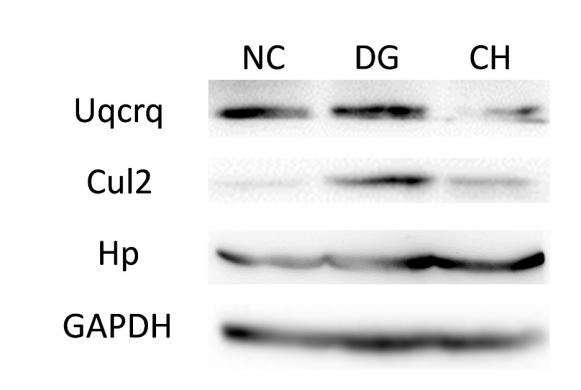UQCRQ Antibody - #DF12496
产品描述
*The optimal dilutions should be determined by the end user.
*Tips:
WB: 适用于变性蛋白样本的免疫印迹检测. IHC: 适用于组织样本的石蜡(IHC-p)或冰冻(IHC-f)切片样本的免疫组化/荧光检测. IF/ICC: 适用于细胞样本的荧光检测. ELISA(peptide): 适用于抗原肽的ELISA检测.
引用格式: Affinity Biosciences Cat# DF12496, RRID:AB_2845301.
展开/折叠
Complex III subunit 8; Complex III subunit VIII; Cytochrome b-c1 complex subunit 8; QCR8; QCR8_HUMAN; QP-C; QPC; Ubiquinol-cytochrome c reductase complex 9.5 kDa protein; Ubiquinol-cytochrome c reductase complex ubiquinone-binding protein QP-C; Uqcrq;
抗原和靶标
- O14949 QCR8_HUMAN:
- Protein BLAST With
- NCBI/
- ExPASy/
- Uniprot
MGREFGNLTRMRHVISYSLSPFEQRAYPHVFTKGIPNVLRRIRESFFRVVPQFVVFYLIYTWGTEEFERSKRKNPAAYENDK
种属预测
score>80的预测可信度较高,可尝试用于WB检测。*预测模型主要基于免疫原序列比对,结果仅作参考,不作为质保凭据。
High(score>80) Medium(80>score>50) Low(score<50) No confidence
翻译修饰 - O14949 作为底物
| Site | PTM Type | Enzyme | Source |
|---|---|---|---|
| R10 | Methylation | Uniprot | |
| R12 | Methylation | Uniprot | |
| S16 | Phosphorylation | Uniprot | |
| Y17 | Phosphorylation | Uniprot | |
| S20 | Phosphorylation | Uniprot | |
| R25 | Methylation | Uniprot | |
| T32 | Phosphorylation | Uniprot | |
| K33 | Ubiquitination | Uniprot | |
| K73 | Ubiquitination | Uniprot | |
| K82 | Acetylation | Uniprot |
研究背景
Component of the ubiquinol-cytochrome c oxidoreductase, a multisubunit transmembrane complex that is part of the mitochondrial electron transport chain which drives oxidative phosphorylation. The respiratory chain contains 3 multisubunit complexes succinate dehydrogenase (complex II, CII), ubiquinol-cytochrome c oxidoreductase (cytochrome b-c1 complex, complex III, CIII) and cytochrome c oxidase (complex IV, CIV), that cooperate to transfer electrons derived from NADH and succinate to molecular oxygen, creating an electrochemical gradient over the inner membrane that drives transmembrane transport and the ATP synthase. The cytochrome b-c1 complex catalyzes electron transfer from ubiquinol to cytochrome c, linking this redox reaction to translocation of protons across the mitochondrial inner membrane, with protons being carried across the membrane as hydrogens on the quinol. In the process called Q cycle, 2 protons are consumed from the matrix, 4 protons are released into the intermembrane space and 2 electrons are passed to cytochrome c.
Mitochondrion inner membrane>Single-pass membrane protein.
Component of the ubiquinol-cytochrome c oxidoreductase (cytochrome b-c1 complex, complex III, CIII), a multisubunit enzyme composed of 11 subunits. The complex is composed of 3 respiratory subunits cytochrome b, cytochrome c1 and Rieske protein UQCRFS1, 2 core protein subunits UQCRC1/QCR1 and UQCRC2/QCR2, and 6 low-molecular weight protein subunits UQCRH/QCR6, UQCRB/QCR7, UQCRQ/QCR8, UQCR10/QCR9, UQCR11/QCR10 and subunit 9, the cleavage product of Rieske protein UQCRFS1 (By similarity). The complex exists as an obligatory dimer and forms supercomplexes (SCs) in the inner mitochondrial membrane with NADH-ubiquinone oxidoreductase (complex I, CI) and cytochrome c oxidase (complex IV, CIV), resulting in different assemblies (supercomplex SCI(1)III(2)IV(1) and megacomplex MCI(2)III(2)IV(2)).
Belongs to the UQCRQ/QCR8 family.
研究领域
· Human Diseases > Endocrine and metabolic diseases > Non-alcoholic fatty liver disease (NAFLD).
· Human Diseases > Neurodegenerative diseases > Alzheimer's disease.
· Human Diseases > Neurodegenerative diseases > Parkinson's disease.
· Human Diseases > Neurodegenerative diseases > Huntington's disease.
· Metabolism > Energy metabolism > Oxidative phosphorylation.
· Metabolism > Global and overview maps > Metabolic pathways.
· Organismal Systems > Circulatory system > Cardiac muscle contraction. (View pathway)
文献引用
Application: WB Species: mice Sample: Liver tissues
限制条款
产品的规格、报价、验证数据请以官网为准,官网链接:www.affbiotech.com | www.affbiotech.cn(简体中文)| www.affbiotech.jp(日本語)产品的数据信息为Affinity所有,未经授权不得收集Affinity官网数据或资料用于商业用途,对抄袭产品数据的行为我们将保留诉诸法律的权利。
产品相关数据会因产品批次、产品检测情况随时调整,如您已订购该产品,请以订购时随货说明书为准,否则请以官网内容为准,官网内容有改动时恕不另行通知。
Affinity保证所销售产品均经过严格质量检测。如您购买的商品在规定时间内出现问题需要售后时,请您在Affinity官方渠道提交售后申请。产品仅供科学研究使用。不用于诊断和治疗。
产品未经授权不得转售。
Affinity Biosciences将不会对在使用我们的产品时可能发生的专利侵权或其他侵权行为负责。Affinity Biosciences, Affinity Biosciences标志和所有其他商标所有权归Affinity Biosciences LTD.

